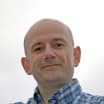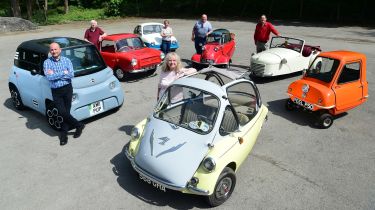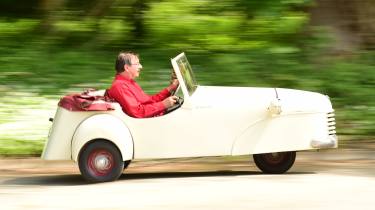Microcars: the tiny cars that were ahead of their time
Think the Citroen Ami is a new idea? Then think again, because microcars are nothing new
There really is nothing new under the sun in the automotive universe. As manufacturers rush towards personal mobility instead of car ownership, with pint-sized city models such as the Fiat Topolino and its cousin, the Citroen Ami, they’re trying to kid us that they’ve hit on something new and innovative.
But we’ve been here before. Back in the fifties, a mass of tiny buzzboxes sprang from nowhere, and in those days they were called microcars. Nowadays they’re sold as quadricycles, which is a step up from a moped rather than being a fully fledged car. But ultimately they’re the same thing: no-frills transport that’s designed to cut mobility costs to a minimum.
During the post-war years materials and money were in short supply, but people still needed to get about. Finding a solution required ingenuity galore, and the result was a raft of cars that brought new meaning to the term ‘basic’. Many of them featured little in the way of equipment, power or performance, but they sold by the thousand to people who needed cheap transport and wanted something better than a moped.
Across the UK and Europe, factories large and small sprang up to churn out cars that often made a Smart ForTwo look corpulent and luxurious. Usually (under-)powered by a single-cylinder two-stroke engine, these tiny vehicles would screech and clatter their way around the streets in a cloud of exhaust fumes.
One of the companies that was among the first to embrace the microcar was Preston-based Sharp’s Commercials, which initially built Minicar three-wheelers and would later branch out into four-wheeled family cars. The firm rebranded itself as Bond in 1963, only to be swallowed up by Reliant six years later.
The white Bond pictured is the oldest car here, and one of the few early Minicars left. It’s one of six Bonds owned by Dennis Jump and dates from 1951, two years after the car entered production. “My dad bought a Minicar as a cheap runabout while his Jaguar’s engine was being rebuilt,” Dennis said. “But I purloined it immediately and set about restoring it, so that I could use it as my everyday transport. Since then I’ve always owned at least one Minicar, and this one has been completely restored. It’s one of just five known to have survived and it’s the only one that’s known to be in regular use.”
The Bond is incredibly basic, but it’s a high-quality aluminium-bodied product built using aircraft principles, because company founder Lawrie Bond’s background was in aviation engineering. Up front is a 197cc single-cylinder engine and there’s a sequential column change for the three-speed gearbox. Inside is a bench seat supposedly capable of seating three abreast, but they’d have to be tiny and on very good terms with each other to fit. There are rod-operated brakes only on the back, and Dennis says you have to plan at least a quarter of a mile ahead, bearing in mind that anything beyond 40mph requires immense bravery thanks to the lack of stability, the bouncy suspension and the lack of power to go as well as to stop.
For some reason microcar owners are incapable of buying just one vehicle and instead they amass collections of varying sizes. Several long-standing owners have collections of 40 or more microcars, but Jenny and Ray Dilks haven’t got it quite that bad. They own six, including three of the cars here, but many others have passed through their hands, and Ray has restored lots more for friends.
Their fleet includes a 1959 Nobel 200 (in blue and cream here), a 1958 Heinkel Kabine (the yellow-and-grey car) and the red 1959 Frisky pictured. Wolverhampton-based Frisky is one of many microcar firms that flourished briefly, before disappearing into obscurity. It’s reckoned that globally, just 70 Friskys of all types have survived.
The Dilks’ microcar obsession started with a BMW Isetta, the classic ‘bubble car’ on account of its wheeled goldfish bowl appearance. Jenny says: “In 1982 we bought the car to restore together, and when it was finished, we started going to club rallies. But with two kids to transport, it was too cramped for four, so in 1986 we bought the Nobel to take along as well. A year later Ray took the Isetta for an MoT and the tester told him that he had a workshop manual for it that he could have for free. But it turned out that the manual was for a Heinkel, which looked similar but is actually a totally different car, so Ray then had to go out and buy a car to go with his free manual.
“Since acquiring the Heinkel, we’ve driven it from London to Edinburgh in 12 hours, as well as undertaking a 1,500-mile road trip that included the Hardknott and Wry Nose Passes in Cumbria. Those were a bit scary,” Jenny tells us, “and I had to get out part-way up because the Heinkel ground to a halt. Plus with braking only on the front wheels, the car just started to bounce back down again because Ray couldn’t hold it on the brakes.”
Since then, the Dilks have bought quite a few more microcars, but they haven’t sold many. In the acquisitions column is the 197cc single-cylinder Frisky Family Three, bought in 2008 as a project, having been laid up since 1971. It’s one of two Friskys that they own, the other being a Sport edition; it’s a true hot-rod, with its two-cylinder engine boasting 325cc of raw power.
Arguably the most recognisable car here is Colin and Sharon Burton’s Messerschmitt KR200. Bought more than 30 years ago, the KR200 was built by an aircraft company that found itself short of orders once WWII ended. Colin says: “I’d always liked Messerschmitts, and in the early nineties I started hunting for one, and this turned up. It needed a total restoration, but thanks to the owners’ club, I found everything I needed. Even now, parts supply is very good, although some bits are getting expensive.
“Nowadays it’s used mainly for fairly local social events, but I drove it to Switzerland and back once, to a car rally. It’ll sit at 50mph all day, but the biggest problem is how hot it gets inside, while the constant buzzing of the 191cc single-cylinder engine permeates the cabin too. On a long trip that can get very tiring, but despite all this it’s enormous fun. It’s definitely not a car for shrinking violets, though!”
The arrival of the Mini in 1959 quickly killed off most of the microcar industry. BMC’s new family car was roomy, practical, comfortable, nippy and fun to drive. It was also cheaper than some of the microcars, so the writing was on the wall for the likes of Messerschmitt, Frisky, Heinkel and Peel Engineering. The last firm built the P50, seen here in replica form (the orange car).This single-seater is the smallest passenger car to ever reach production, and like most microcars nowadays, values have skyrocketed.
But what are they like to drive? After making sure my life insurance is up to date, I fall backwards onto the Heinkel’s front bench seat and pull the door shut in front of me, which brings the steering wheel with it. Press the key down and the 198cc single-cylinder engine roars into life. I now have a tantalising 10bhp at my disposal; I just need to select a gear from the sliding sequential mechanism to my left. It’s all a bit vague, but more by luck than judgment I ease the selector into first and we’re off.
The floor-hinged pedals are mounted close to each other, but somehow I manage to get into second and then third, by which point it feels as though I’m breaking the sound barrier, such is the din. I’m being bounced all over the place, thanks to the crude suspension and flat, unsupportive seat, but a glance at the speedometer reveals that I’m about to hit the giddy heights of 20mph.
It seems I’ve got away lightly, because Ray tells me that of all the cars here, the Heinkel is probably the most accomplished dynamically. Which rather begs the question: why does anyone buy a classic microcar?
Ray’s response is predictable: “Because they’re quirky! The microcar scene is full of interesting people and interesting cars that are an important part of our history.
“Sure, they have limited performance, but people love them and film us every time we go out. People go into microcar ownership knowing they’ll be the centre of attention, but in a good way, because these cars make people smile, and that’s what it’s all about.”
Citroen Ami is the modern microcar
During the eighties and nineties, a raft of companies sprang up across Europe to make a new breed of microcar, now called light quadricycles and officially recognised by EU legislators. They can be driven by children as young as 14, but there are strict limits on power (8bhp), maximum performance (28mph) and weight (425kg, without batteries if an EV), and it’s these rules that have led to the introduction of the electric Citroen Ami, Opel Rocks and their cousin, the Fiat Topolino.
As a modern-day microcar, the Ami fits into this group perfectly because it shows how far things have moved on in the past 65 years or so – but it’s not all progress. Compared with any of the classics, the Ami is a breeze to drive with its automatic transmission and effective brakes, and while it’s bouncy because the suspension is too firm, the Citroen is genuinely fun.
It also has an airy, spacious cabin that is very basic, but that’s part of its charm. Indeed, the Ami exudes simplicity everywhere you look, from its minimal switchgear and instrumentation to the door mirrors that are manually adjusted.
The Ami is just as charming on the outside; everyone notices it as you drive by, and they all love it. That’s assuming they see it of course, because the chances are they won’t hear it, given that the sound of an electric motor can’t compete with the chainsaw-like racket from the tiny asthmatic engines in the classics.
But where the Ami can’t compete with the oldies is in range. The classics might be slow, but you can fill the tank and drive them for a couple of hundred miles before refuelling in minutes and doing it all again (if your ears and spine can take it). The Ami runs out of juice after no more than 46 miles, says Citroen, then it takes three hours to recharge the 5.5kWh battery. The irony is that of all the cars here, the Ami is easily the best for undertaking a really long journey. Not that our classic owners would agree, though.
Click here for our list of the best small cars...
Find a car with the experts








